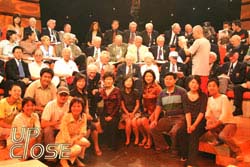Source: CCTV.com
08-01-2006 15:12
 |
More then 60 years ago, the American Volunteer Group came as civilian volunteers from America, thousands of miles from their homes, to help China fight against the Japanese and transport critical supplies during the Chinese People's War against Japanese Invasion. As their nickname demonstrates, these talented, energetic, adventurous and spirited young men were tigers in the sky, roaring their way to victory, and conquering the hearts and souls of the people of China and the world.
 |
In the summer of 1938, Claire L. Chennault, a retired captain of the United States Army Air Corps, accepted an offer from Soong Meiling, Madame Chiang Kai-shek, and arrived in South-West China’s Kunming city to forge a new Chinese Air Force to help China fight against Japanese invasion. In 1941, with secret support from the Roosevelt Administration, Chennault recruited American pilots and technicians under the name of private constitution. Later that year, over 200 members came to China. AVG fighter planes were painted with large shark teeth on the front of the plane. About the same time, they were dubbed "Flying Tigers". During the war, The Tigers flew old and broken planes to transport needed materials from India to China across the Himalayas, shielded the Myanmar road, and won air combat against the much better-equipped and larger-scaled Japanese air force in most areas of China. After the AVG was disbanded on July 4, 1942, the China Air Task Force of the United States Army Air Force officially took over air operations in China. In early March of 1943, the 14th Air Force was activated under the command of Chennault and replaced the China Air Task Force. Chennault was promoted to Brigadier and later Major General as Commander of the Fourteenth Air Force. By the end of the war in 1945, the Flying Tigers shot down all together 2600 planes, and destroyed or sank 44 warships. Most of the members of the Flying Tigers received rewards from the Chinese government. Over 10 pilots were awarded with Aviation Squadron insignia from the American or British governments. Just before their 50th reunion in 1992, the AVG veterans were retroactively recognized as members of the U.S. military service. Survivors were made eligible for veterans' benefits on the basis of that service, and were awarded medals for their participation.
 |
At the 60th anniversary of China's victory over the Japanese Aggression, more than 100 AVG veterans and their family members were invited back to China and attended a series of activities, including meeting with Chinese leaders and friends, visiting cemeteries and memorials, and searching for wreckage from the war.
“Up-Close” is so honored to have some 30 Flying Tigers gather in the studio to tell their wartime stories and their lives after the Flying Tigers. They say they were the lucky ones because although 1500 of their companions died in the war, our guests went back home safely and became military officials, businessmen, politicians, and even a producer of cartoons. But, in fact, we feel that the viewers, studio audience and production team of “Up-Close” are even luckier, since this program is not only a precious reunion for the veterans, but is also a special record of a period of history which changed a country's fate. Their stories prove that by bearing history in mind, we will further cherish peace and a harmonious future for the world. --- Written by Chai Haoran
Editor:Chen

